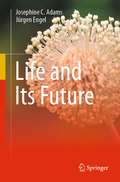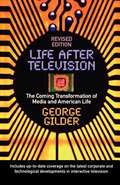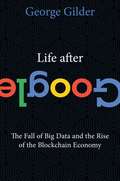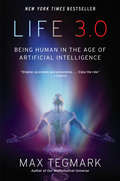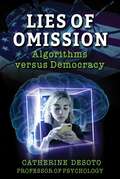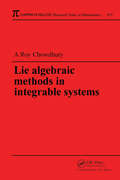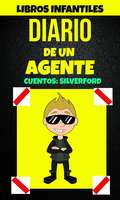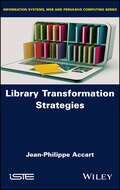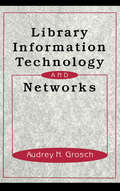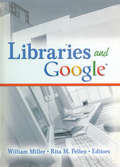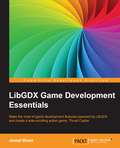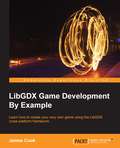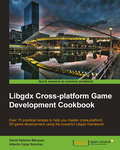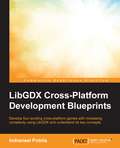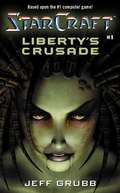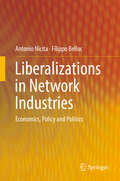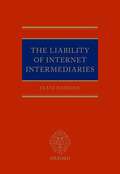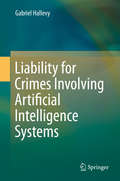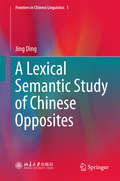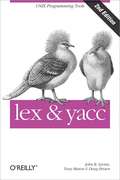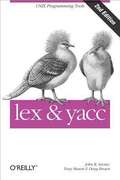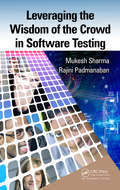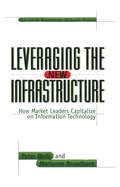- Table View
- List View
Life and Its Future
by Josephine C. Adams Jürgen EngelThis book is aimed at those who wish to understand more about the molecular basis of life and how life on earth may change in coming centuries. Readers of this book will gain knowledge of how life began on Earth, the natural processes that have led to the great diversity of biological organisms that exist today, recent research into the possibility of life on other planets, and how the future of life on earth faces unprecedented pressures from human-made activities. Readers will obtain a perspective on the potential risks of chemical or nuclear warfare, and the ever-increasing risks from human activities that are causing pollution and climate change with global heating. Readers will also learn about ongoing research efforts to generate “designer lifeforms” through synthetic biology and applications of artificial intelligence. The book makes an integrated, up-to-date, overview of topics often considered as separate fields. It should be valuable to students, teachers, and people who are concerned about the future of life.
Life After Television
by George GilderPredicts that personal computers linked into a global network will soon replace television, and thereby overthrow the tyranny of mass media, renew individual power, and promote democracy worldwide. Urges American business to get on the ball with fiber optics. Reprinted from the 1990 edition published by Whittle Books. No index or bibliography.
Life After Google: The Fall of Big Data and the Rise of the Blockchain Economy
by George Gilder“Google’s algorithms assume the world’s future is nothing more than the next moment in a random process. George Gilder shows how deep this assumption goes, what motivates people to make it, and why it’s wrong: the future depends on human action.” — Peter Thiel, founder of PayPal and Palantir Technologies and author of Zero to One: Notes on Startups, or How to Build the Future. “If you want to be clued in to the unfolding future, then you have come to the right place. For decades, George Gilder has been the undisputed oracle of technology’s future. Are giant companies like Google, Amazon, and Facebook the unstoppable monopolistic juggernauts that they seem, or are they dysfunctional giants about to be toppled by tech-savvy, entrepreneurial college dropouts?” — Nick Tredennick, Ph.D., Chief Scientist, QuickSilver Technolog Silicon Valley’s Nervous Breakdown The Age of Google, built on big data and machine intelligence, has been an awesome era. But it’s coming to an end. In Life after Google, George Gilder—the peerless visionary of technology and culture—explains why Silicon Valley is suffering a nervous breakdown and what to expect as the post-Google age dawns. Google’s astonishing ability to “search and sort” attracts the entire world to its search engine and countless other goodies—videos, maps, email, calendars….And everything it offers is free, or so it seems. Instead of paying directly, users submit to advertising. The system of “aggregate and advertise” works—for a while—if you control an empire of data centers, but a market without prices strangles entrepreneurship and turns the Internet into a wasteland of ads. The crisis is not just economic. Even as advances in artificial intelligence induce delusions of omnipotence and transcendence, Silicon Valley has pretty much given up on security. The Internet firewalls supposedly protecting all those passwords and personal information have proved hopelessly permeable. The crisis cannot be solved within the current computer and network architecture. The future lies with the “cryptocosm”—the new architecture of the blockchain and its derivatives. Enabling cryptocurrencies such as bitcoin and ether, NEO and Hashgraph, it will provide the Internet a secure global payments system, ending the aggregate-and-advertise Age of Google. Silicon Valley, long dominated by a few giants, faces a “great unbundling,” which will disperse computer power and commerce and transform the economy and the Internet. Life after Google is almost here. For fans of "Wealth and Poverty," "Knoweldge and Power," and "The Scandal of Money."
Life 3.0: Being Human in the Age of Artificial Intelligence
by Max TegmarkNew York Times Best SellerHow will Artificial Intelligence affect crime, war, justice, jobs, society and our very sense of being human? The rise of AI has the potential to transform our future more than any other technology—and there&’s nobody better qualified or situated to explore that future than Max Tegmark, an MIT professor who&’s helped mainstream research on how to keep AI beneficial. How can we grow our prosperity through automation without leaving people lacking income or purpose? What career advice should we give today&’s kids? How can we make future AI systems more robust, so that they do what we want without crashing, malfunctioning or getting hacked? Should we fear an arms race in lethal autonomous weapons? Will machines eventually outsmart us at all tasks, replacing humans on the job market and perhaps altogether? Will AI help life flourish like never before or give us more power than we can handle? What sort of future do you want? This book empowers you to join what may be the most important conversation of our time. It doesn&’t shy away from the full range of viewpoints or from the most controversial issues—from superintelligence to meaning, consciousness and the ultimate physical limits on life in the cosmos.
Lies of Omission: Algorithms versus Democracy
by Catherine DeSotoA lie of omission—withholding needed information to correct a false belief. There is a sharp and more hostile divide emerging in the United States. The shift is documented by various polls, and the speed of the change is alarming. There are certainly contributing factors, but one factor is unique to the contemporary era: receiving the majority of our information via social media experiences. Media algorithms, and to some extent overt censorship, serve users curated content that is unlike what their neighbors receive.Lies of Omission brings together various perspectives on the causes and effects of the divided information streams. Psychology and neuroscience, combined with some historical jurisprudence, are woven together to spell out the dangers of the modern social media experience. Importantly, the human response can be understood as rooted in our psychology and neurochemistry. In part two of the book, eight hot button issues that have provoked deep divisions among American citizens are presented as well-researched, opposing-view chapters with a goal to lay bare the extent of the disinformation gap that we are living in. With the rise of ephemeral smart media, and the associated displacement of the permanently printed word, it is rare to have a clear idea of what persons who do not share our opinions actually believe, or why.The decimation of communal information sources is nearly complete. What can one do? One concrete step is to turn some of your attention away from curated, impermanent news and read a book. Read this book. Dr. Catherine DeSoto spells out why it is worth our time to be informed regarding the issues we care about: something your phone&’s curated media will never do for you. Open your mind to the quaint idea that one is not informed unless one understands the opposing view. Surprising all-new research regarding the political divide and the pandemic is included. Together with over 150 references, this book will be the definitive source documenting the effects of the media algorithm revolution.
Lie Algebraic Methods in Integrable Systems (Chapman And Hall/crc Research Notes In Mathematics Ser. #Vol. 415)
by Amit K. Roy-ChowdhuryOver the last thirty years, the subject of nonlinear integrable systems has grown into a full-fledged research topic. In the last decade, Lie algebraic methods have grown in importance to various fields of theoretical research and worked to establish close relations between apparently unrelated systems. The various ideas associated with Lie algebra and Lie groups can be used to form a particularly elegant approach to the properties of nonlinear systems. In this volume, the author exposes the basic techniques of using Lie algebraic concepts to explore the domain of nonlinear integrable systems. His emphasis is not on developing a rigorous mathematical basis, but on using Lie algebraic methods as an effective tool.The book begins by establishing a practical basis in Lie algebra, including discussions of structure Lie, loop, and Virasor groups, quantum tori and Kac-Moody algebras, and gradation. It then offers a detailed discussion of prolongation structure and its representation theory, the orbit approach-for both finite and infinite dimension Lie algebra. The author also presents the modern approach to symmetries of integrable systems, including important new ideas in symmetry analysis, such as gauge transformations, and the "soldering" approach. He then moves to Hamiltonian structure, where he presents the Drinfeld-Sokolov approach, the Lie algebraic approach, Kupershmidt's approach, Hamiltonian reductions and the Gelfand Dikii formula. He concludes his treatment of Lie algebraic methods with a discussion of the classical r-matrix, its use, and its relations to double Lie algebra and the KP equation.
Libros Infantiles: Silverford)
by Alex Anderson Nicol Pizarro¿Te gusta Silverford? El mundo que conocemos va a cambiar para Siempre. El Señor Oscuro está a punto de liberar el cubo cósmico, la fuente de energía para todo el universo. Ahora el agente Jack, Steve y Notch deberán proteger el mundo de Silverford. Libro 1: La saga del cubo cósmico – La Tierra Misteriosa: Esta es la primera parte de las series del Agente de Silverford. Jack es elegido por Notch para una misión extremadamente secreta llamada “Proyecto Z”. Esta misión es muy peligrosa y no hay seguridad de que sea exitosa, pero la misión es esencial para el futuro del Mundo de Silverford. En esta saga, serán revelados secretos raros y oscuros de Silverford. Así que, ¿qué estás esperando? Libro 2: La saga del cubo cósmico – El valle de la Muerte: Esta es la segunda parte del “Diario de un Agente de Silverford”. En este libro seguimos en donde nos quedamos en la primera parte. Jack y su equipo enfrentan obstáculos y callejones sin salida pero continúan. Esta es la continuación de uno de los libros más controversiales e impresionantes jamás escritos sobre Silverford. Se revelaron muchos secretos en el primer libro y muchos se revelarán en este. Así que ¡A leer! Libro 3: La saga del cubo cósmico – El secreto de Notch: Esta es la tercera parte del “Diario de un Agente de Silverford”. Las aventuras de Jack se vuelven más peligrosas. El “proyecto Z” es cada vez más misterioso. Entérate cómo Jack y su equipo experimentan diferentes obstáculos. Giros inésperados te mantendrán en suspenso queriendo leer más. Libro 4: El cubo cósmico - La batalla del Oscuro: La saga del Agente de Silverford continúa en esta cuarta entrega, la más impresionante de Silverford jamás escrita. Las cosas toman un giro inesperado después de la llegada de una figura encapuchada. ¿Quién es? En este libro, resolverás este misterio y muchos más. ¿Serán ver
Library Transformation Strategies
by Jean-Philippe AccartLibraries continually focus on adaptation and adopt different transformation strategies to achieve this goal. These strategies demonstrate a clear desire to stay in tune with the times, while retaining the basic principles that underpin their day-to-day work and ensure they continue to exist. This book is a complete synthesis, a helpful resource for librarians and information professionals that develops four major strategies. The first focuses on understanding the environment and society, with organizational changes affecting cultural institutions (public or private), and the emergence of the library space. The second shows how management methods evolve within them (participatory approach, benevolence, empathy) with an emphasis on project management. The third strategy focuses on the integration of new library tools to better reach audiences. Finally, the fourth develops an essential and indispensable aspect of library marketing. This book is a complete synthesis, a helpful resource for librarians and information professionals that develops four major strategies. The first focuses on understanding the environment and society, with organizational changes affecting cultural institutions (public or private), and the emergence of the library space. The second shows how management methods evolve within them (participatory approach, benevolence, empathy) with an emphasis on project management. The third strategy focuses on the integration of new library tools to better reach audiences. Finally, the fourth develops an essential and indispensable aspect of library marketing.Libraries continually focus on adaptation and adopt different transformation strategies to achieve this goal. These strategies demonstrate a clear desire to stay in tune with the times, while retaining the basic principles that underpin their day-to-day work and ensure they continue to exist. This book is a complete synthesis, a helpful resource for librarians and information professionals that develops four major strategies. The first focuses on understanding the environment and society, with organizational changes affecting cultural institutions (public or private), and the emergence of the library space. The second shows how management methods evolve within them (participatory approach, benevolence, empathy) with an emphasis on project management. The third strategy focuses on the integration of new library tools to better reach audiences. Finally, the fourth develops an essential and indispensable aspect of library marketing. Jean-
Library Information Technology and Networks
by Charles GroschOffers an historical perspective of the past 25 years of computers in libraries, profileing currently available processing systems according to their size and platform. The short- and long-term future of information technology in libraries.;College or university bookstores may order five or more copies at a special student price which is available from Marcel Dekker upon request.
Libraries and Google: New Google Applications And Tools For Libraries And Library Users
by William Miller Rita M. PellenDiscover the benefits-and drawbacks-of Google® Google® has become a nearly omnipresent tool of the Internet, with its potential only now beginning to be realized. How can librarians effectively integrate this powerful search engine to provide service to their patrons? Libraries and Google® presents leading authorities discussing the many possibilities of using Google® products as effective, user-friendly tools in libraries. Google Scholar and Print are extensively explored with an eye toward offering an expanded view of what is and may be possible for the future, with practical insights on how to make the most of the product&’s capabilities.It seems certain that Google® is here to stay. Libraries and Google® comprehensively examines this "disruptive technology" that is seen as both a threat and an opportunity by both librarians and publishers. Both perspectives are explored in depth, along with practical applications of this and other Google® technology that may be new to librarians. Google® products and other more familiar research tools are compared for effectiveness and ease of use. The various unique needs of users and scholars are detailed and considered as a springboard for insightful discussion of the future role of librarians in today&’s world. Potential problems are closely examined, such as copyright issues of digitization, and privacy concerns sparked by its collection of personal information about its users. The book comprehensively explores the path libraries need to travel to benefit from the search tool, rather than being overwhelmed and destroyed by it.Topics in Libraries and Google® include: the viewpoint that Google® may make libraries obsolete new opportunities for libraries through using Google® products technical aspects of purchasing and implementing Google® search products with proprietary vendor databases testing the performance of Google Scholar and Print practical use of Google®&’s products personal privacy issues making digitized library resources more accessible digitization of copyrighted materials much, much more!Libraries and Google® is horizon-expanding reading for all librarians, library science educators and students, library administrators, publishers, and university presses.Volume 2 of Libraries and Google® is in preparation.Google® is a Registered Service Mark of Google, Inc., Mountain View, California. Libraries and Google® is an independent publication offered by The Haworth Press, Inc., Binghamton, New York, and is not affiliated with, nor has it been authorized, sponsored, endorsed, licensed, or otherwise approved by, Google, Inc.
Liblouisxml User's and Programmer's Manual
by Viewplus Technologies AbilitiessoftA user's and programmer's guide for Liblouisxml, a software component for translating XML into braille.
Liblouis User's and Programmer's Manual
by AbilitiessoftA guide for users and programmers on Liblouis, an open-source braille translator and back-translator.
LibGDX Game Development Essentials
by Juwal BoseIf you are a Java developer who wants to learn LibGDX and create great games, then this book is for you. To take full advantage of this book, you are expected to be familiar with Java or any other object-oriented language. Experience of using Eclipse will be very useful.
LibGDX Game Development By Example
by James CookLearn how to create your very own game using the libGDX cross-platform framework About This Book * Learn the core features of libGDX to develop your own exciting games * Explore game development concepts through example projects * Target games for major app stores quickly and easily with libGDX's cross-platform functionality Who This Book Is For This book is intended for those who wish to learn the concepts of game development using libGDX. An understanding of Java and other programming languages would definitely be helpful, although it is not a must. What You Will Learn * Create and configure a libGDX project to get started with making games * Get to grips with a simple game loop that will drive your games * Manage game assets to reduce code duplication and speed up development * Pack game assets together into single assets to increase your game's performance * Display textures on the screen and manipulate them with play input * Play various types of sounds that a game can generate * Design and modify a game user interface with libGDX's built-in tools * Develop a game that will run across various platforms In Detail LibGDX is a cross-platform game development framework in Java that makes game programming easier and fun to do. It currently supports Windows, Linux, Mac OS X, Android, and HTML5. With a vast feature set on offer, there isn't a game that can't be made using libGDX. It allows you to write your code once and deploy it to multiple platforms without modification. With cross-platform delivery at its heart, a game can be made to target the major markets quickly and cost effectively. This book starts with a simple game through which the game update cycle is explained, including loading textures onto your screen, moving them around, and responding to input. From there you'll move on to more advanced concepts such as creating a formal game structure with a menu screen, adding a game screen and loading screen, sprite sheets, and animations. You'll explore how to introduce a font to optimize text, and with the help of a game that you'll create, you'll familiarise yourself with the 2D tile map API to create worlds that scroll as the characters move. In the final sample game of the book, you'll implement a basic version of an Angry Birds clone, which will allow you to use the physic library box2D that libGDX provides access to. An overview of exporting games to different platforms is then provided. Finally, you will discover how to integrate third-party services into games and take a sneak peak at the Social Media API to get a basic understanding of how it fits into the libGDX ecosystem. Style and approach With this book you'll learn game development with libGDX through example game projects. You'll finish the book with a thorough understanding of libGDX game development, along with completed games that you'll have built yourself.
Libgdx Cross-platform Game Development Cookbook
by David Saltares Marquez Alberto Cejas SanchezIf you want to make cross-platform games without the hassle and dangers of writing platform-specific code, or If you are a game programmer who may have some experience with Java and you want to learn everything you need to know about Libgdx to produce awesome work, this is the book for you. To take full advantage of the recipes in this book, you are expected to be familiar with java with good game programming knowledge.
LibGDX Cross-Platform Development Blueprints
by Indraneel PotnisDevelop four exciting, cross-platform games using LibGDX with increasing complexity and understand its key concepts About This Book * Learn how to make a complete game from scratch using the LibGDX framework * Discover different aspects of game development, optimize them, and implement them in your games * This is a comprehensive guide packed with concepts that are covered in an incremental manner Who This Book Is For If you have a good grip of Java and want to explore its capabilities in game development, this book is for you. Basic knowledge of LibGDX is preferred, but is not mandatory. What You Will Learn * Set up the development environment and implement a very simple game type * Implement new features such as motion, sounds, and randomness by implementing a new game * Add music, physics, and menus to your games * Start the creation of a platformer game and apply optimisation techniques * Perform collision detection and manage the game assets * Render game levels designed in the tool and add enemies * Create multiple levels, enemy motion, and level transitions in the game In Detail LibGDX is a very popular open source game framework for the Java programming language. It features deployment to multiple platforms with the same code base and it is very fast. Its vast amount of features makes it very easy to learn and master game development without knowing the low-level details. LibGDX Cross-platform Development Blueprints teaches you the concepts of game development using the LibGDX framework as you make four complete games. You'll start with setting up the environment, then move on to advanced concepts such as collision detection, memory optimization, and more. The first game is Monty Hall, where you'll learn how to set up LibGDX and use simple graphics. Then, you'll get to know more about concepts such as animation, game sounds, and scoring by developing a Whack a Mole game. This will set up the base for a Bounce the Ball game, where you'll get to grips with advanced concepts such as movements and collisions based on physics. Finally, the Dungeon Bob game will help you understand player motion. This guide gives you everything you need to master game development with LibGDX. Style and approach This is an easy-to-understand guide, packed with examples and illustrations along the way. Complex areas are broken down into bite-size chunks and are explained in detail. The difficulty levels of games are built throughout the chapters.
Liberty's Crusade
by Jeff GrubbFar in the future, 60,000 light-years from Earth, a loose confederacy of Terran exiles is locked in battle with the enigmatic Protoss and the ruthless Zerg Swarm. Each species struggles to ensure its own survival among the stars in a war that will herald the beginning of mankind's greatest chapter -- or foretell its violent, bloody end. Danny Liberty was a good reporter...too good. When his investigations struck too close to the heart of the corrupt Terran Confederacy, he faced a simple choice: continue his current series of exposés, or take a hazardous new assignment covering the Marines on the front lines of the Koprulu Sector. It didn't take him long to decide.... Behind the attacks of the Zerg and the Protoss lies the story of a lifetime, but every piece of information blurs the mystery further. Thrown into the middle of a war where the outcome will determine mankind's very survival, the only thing that Danny Liberty knows for sure is that the only person he can trust to keep him alive is himself. Liberty's Crusade The first in an epic new series of space warfare novels set in the world of the bestselling computer game!
Liberalizations in Network Industries
by Antonio Nicita Filippo BellocThis book explores the wave of liberalization reforms experienced by OECD network industries. Focusing on the telecommunications sector, the authors analyze the latest data available on liberalization and privatization, and following a political economics approach, they integrate standard economic analysis with the most recent studies of the political determinants of market-oriented policies. The book presents new econometric evidence on several policy issues, including institutional complementarities dynamics, the problem of policy sequencing and the role of government political ideology. The detailed and comprehensive discussion offers insights into how so many countries adopting similar reforms actually differ in their policy bundling, intensity and implementation of liberalization and privatization. "
The Liability of Internet Intermediaries
by Jaani Riordan<P>There is no book dedicated to the doctrines and remedies which regulate the legal liability of internet intermediaries.<P> This is surprising, given that we live in an era in which almost all communications and transactions rely upon services provided or facilitated by such intermediaries.
Liability for Crimes Involving Artificial Intelligence Systems
by Gabriel HallevyThe book develops a general legal theory concerning the liability for offenses involving artificial intelligence systems. The involvement of the artificial intelligence systems in these offenses may be as perpetrators, accomplices or mere instruments. The general legal theory proposed in this book is based on the current criminal law in most modern legal systems. In most modern countries, unmanned vehicles, sophisticated surgical systems, industrial computing systems, trading algorithms and other artificial intelligence systems are commonly used for both industrial and personal purposes. The question of legal liability arises when something goes wrong, e. g. the unmanned vehicle is involved in a car accident, the surgical system is involved in a surgical error or the trading algorithm is involved in fraud, etc. Who is to be held liable for these offenses: the manufacturer, the programmer, the user, or, perhaps, the artificial intelligence system itself? The concept of liability for crimes involving artificial intelligence systems has not yet been widely researched. Advanced technologies are forcing society to face new challenges, both technical and legal. The idea of liability in the specific context of artificial intelligence systems is one such challenge that should be thoroughly explored.
A Lexical Semantic Study of Chinese Opposites (Frontiers in Chinese Linguistics #1)
by Jing DingThis book studies Chinese opposites. It uses a large corpus (GigaWord) to trace the behavior of opposite pairings' co-occurrence, focusing on the following questions: In what types of constructions, from window-size restricted and bi-syllabic to quad-syllabic, will the opposite pairings appear together? And, on a larger scale, i. e. in constrained-free contexts, in which syntactic frames will the opposite pairings appear together? The data suggests aspects that have been ignored by previous theoretical studies, such as the ordering rules in co-occurrent pairings, the differences between the three main sub-types of opposites (that is, antonym, complementary, converse) in discourse function distributions. The author also considers the features of this Chinese study and compares it to similar studies of English and Japanese. In all, it offers a practical view of how opposites are used in a certain language as a response to the puzzles lingering in theoretical fields. This study appeals to linguists, computational linguists and language-lovers. With numerous tables, illustrations and examples, it is easy to read but also encourages readers to link their personal instincts with the results from a large corpus to experience the beauty of language as a shared human resource.
Lex & Yacc, 2nd Edition
by Doug Brown John Levine Tony Mason<p>Shows programmers how to use two Unix utilities, <i>lex</i> and <i>yacc,</i> in program development. You'll find tutorial sections for novice users, reference sections for advanced users, and a detailed index. Major MS-DOS and Unix versions of <i>lex</i> and <i>yacc</i> are explored in depth. Also covers Bison and Flex.</p>
lex & yacc, 2nd Edition
by John R. Levine Tony Mason Doug BrownThis book shows you how to use two Unix utilities, lex and yacc, in program development. These tools help programmers build compilers and interpreters, but they also have a wider range of applications. The second edition contains completely revised tutorial sections for novice users and reference sections for advanced users. This edition is twice the size of the first and has an expanded index. The following material has been added: *Each utility is explained in a chapter that covers basic usage and simple, stand-alone applications *How to implement a full SQL grammar, with full sample code *Major MS-DOS and Unix versions of lex and yacc are explored in depth, including AT&T lex and yacc , Berkeley yacc, Berkeley/GNU Flex, GNU Bison, MKS lex and yacc, and Abraxas PCYACC.
Leveraging the Wisdom of the Crowd in Software Testing
by Mukesh Sharma Rajini PadmanabanIts scale, flexibility, cost effectiveness, and fast turnaround are just a few reasons why crowdsourced testing has received so much attention lately. While there are a few online resources that explain what crowdsourced testing is all about, there's been a need for a book that covers best practices, case studies, and the future of this technique. Filling this need, Leveraging the Wisdom of the Crowd in Software Testing shows you how to leverage the wisdom of the crowd in your software testing process. Its comprehensive coverage includes the history of crowdsourcing and crowdsourced testing, implementation practices, and future trends. The book discusses best practices in implementation-explaining what, when, and how to crowdsource in a testing effort. It also includes case studies that illustrate how both product and service companies have successfully applied crowdsourcing in their testing programs. Explaining how to use the combined advantages of crowdsourcing and cloud computing for software testing, the book examines various engagement models in which you could implement crowdsourced testing. It addresses effective defect management in crowdsourced testing and considers both the business and engineering aspects of crowdsourced testing. The book explores the challenges, limitations, and situations when crowdsourced testing will not work and provides powerful best practices for mitigating the constraints and challenges, including how to build a crowdsourcing platform to test software products. Covering career opportunities for crowd testers, the book concludes by taking a look at the need to build a crowdsourced testing ecosystem, who the players of such an ecosystem would be, and who would need to champion such an effort.
Leveraging the New Infrastructure
by Peter Weill Marianne BroadbentImagine thinking about your company's information technology in the same way that you think about its investment portfolio: as a bundle of assets that--when managed right--will generate revenues and savings. Here's just such a framework for leveraging IT (technology, networks, data, and software)--one that enables business managers to make the important decisions about the potentially confounding mix of high-technology that influences near- and long-term planning, affects the ability to support customers, and dictates the flow of daily operations. Drawing upon their rigorous research with more than 100 top multinationals, the authors present a rich and varied range of examples of IT investment strategies that have reaped rewards for firms such as Citibank, Honda, Johnson & Johnson, Ralston Purina, the Development Bank of Singapore, and Telstra. This hands-on resource, compete with benchmarks and case studies, creates the common ground where both management and IT can meet, communicate their goals, and agree on the best plan for getting there.
